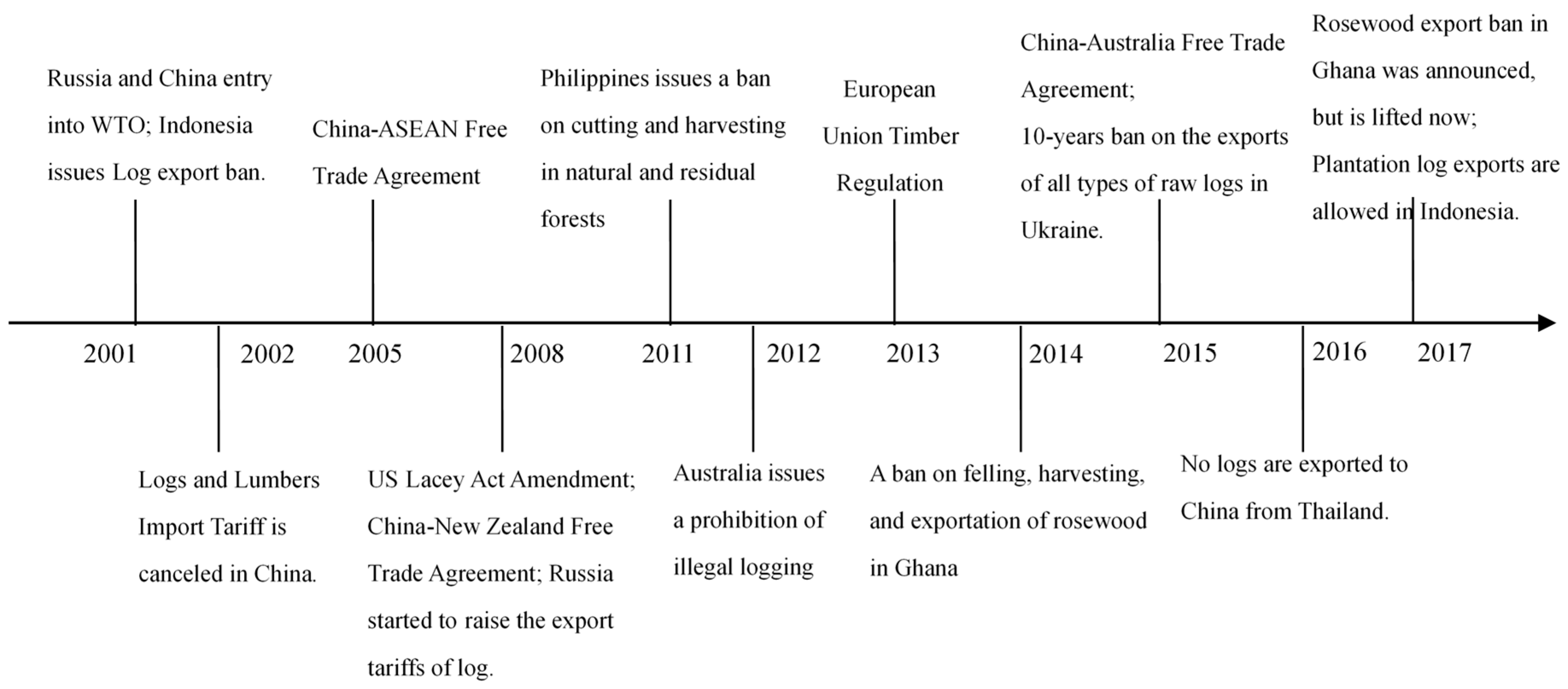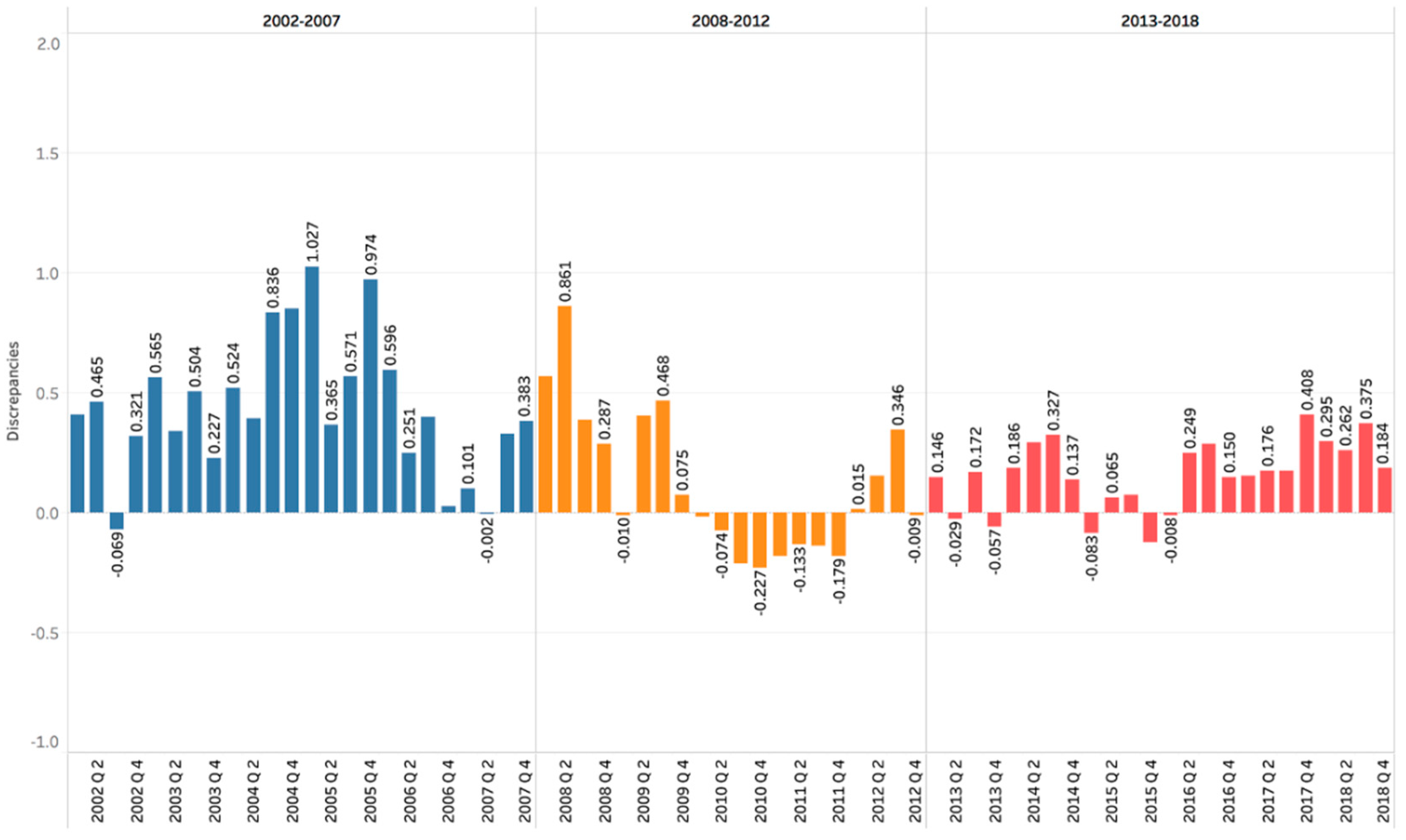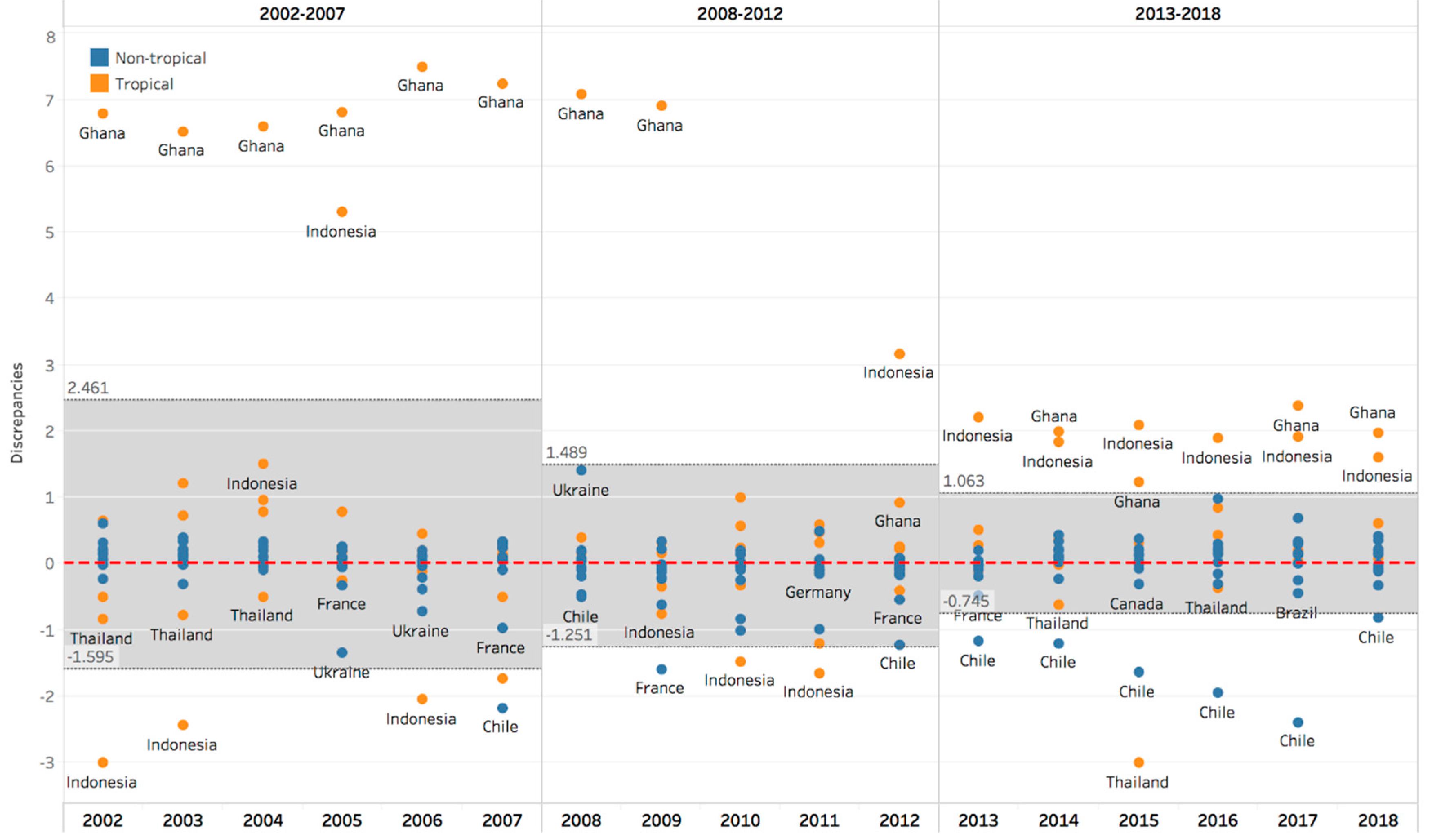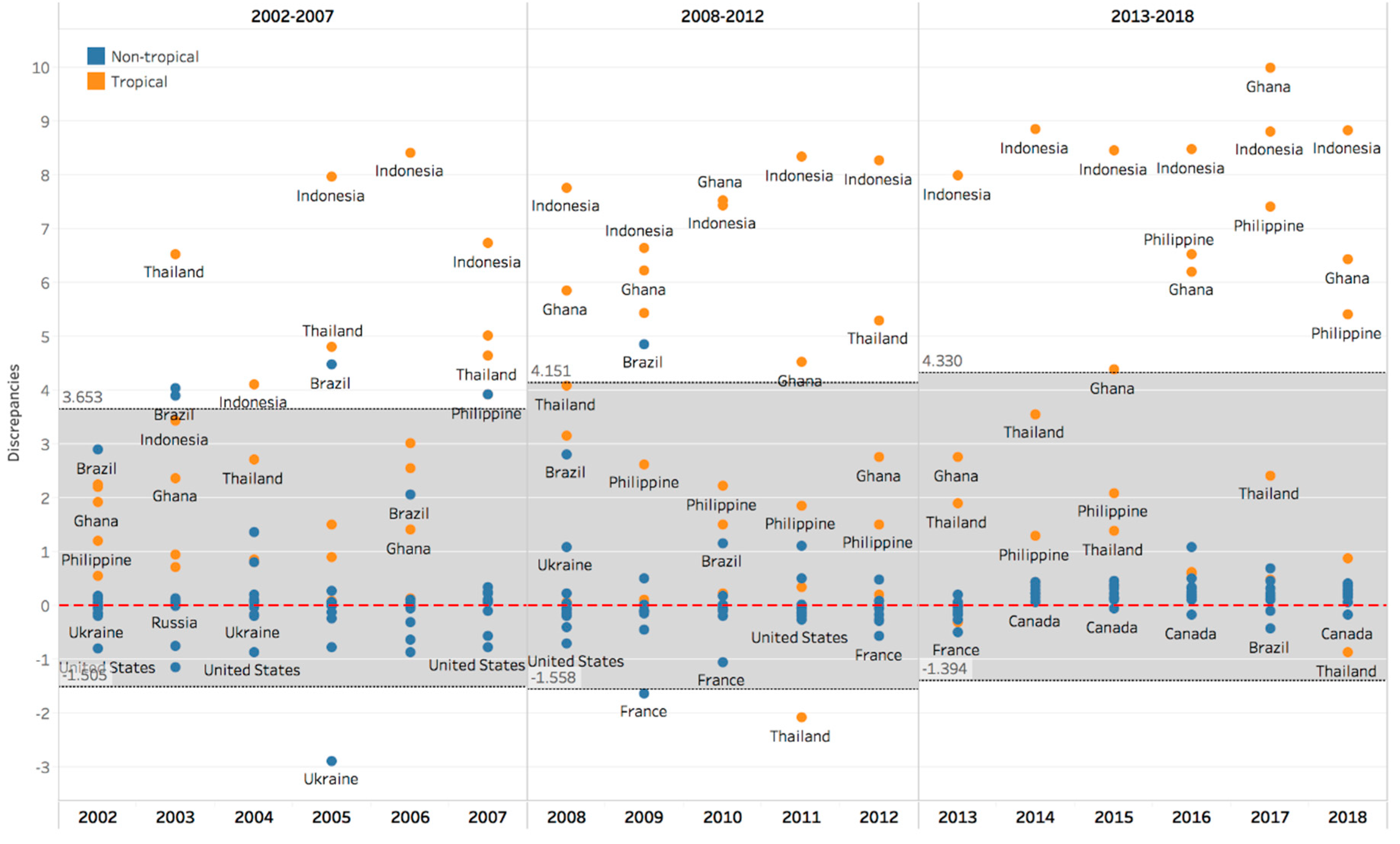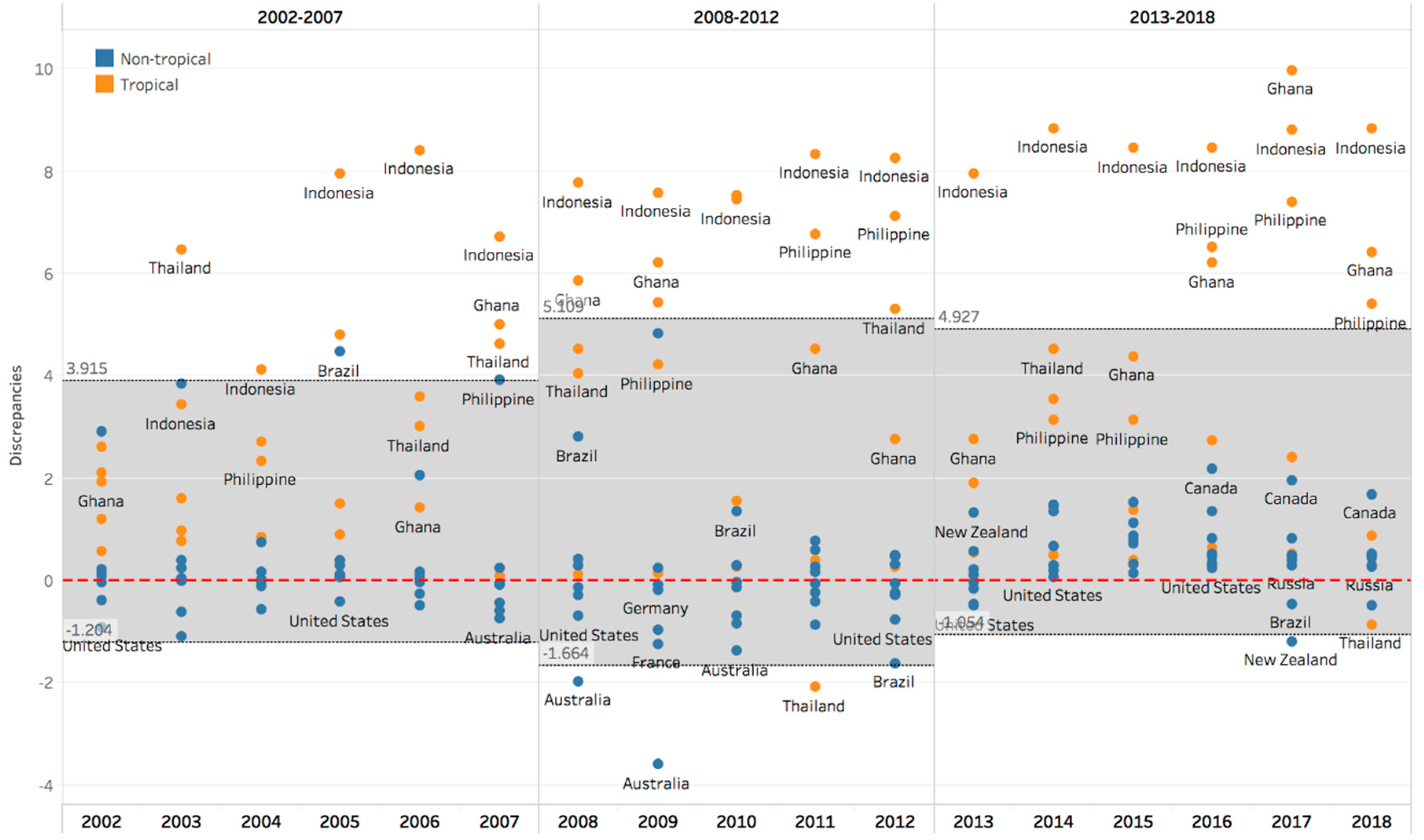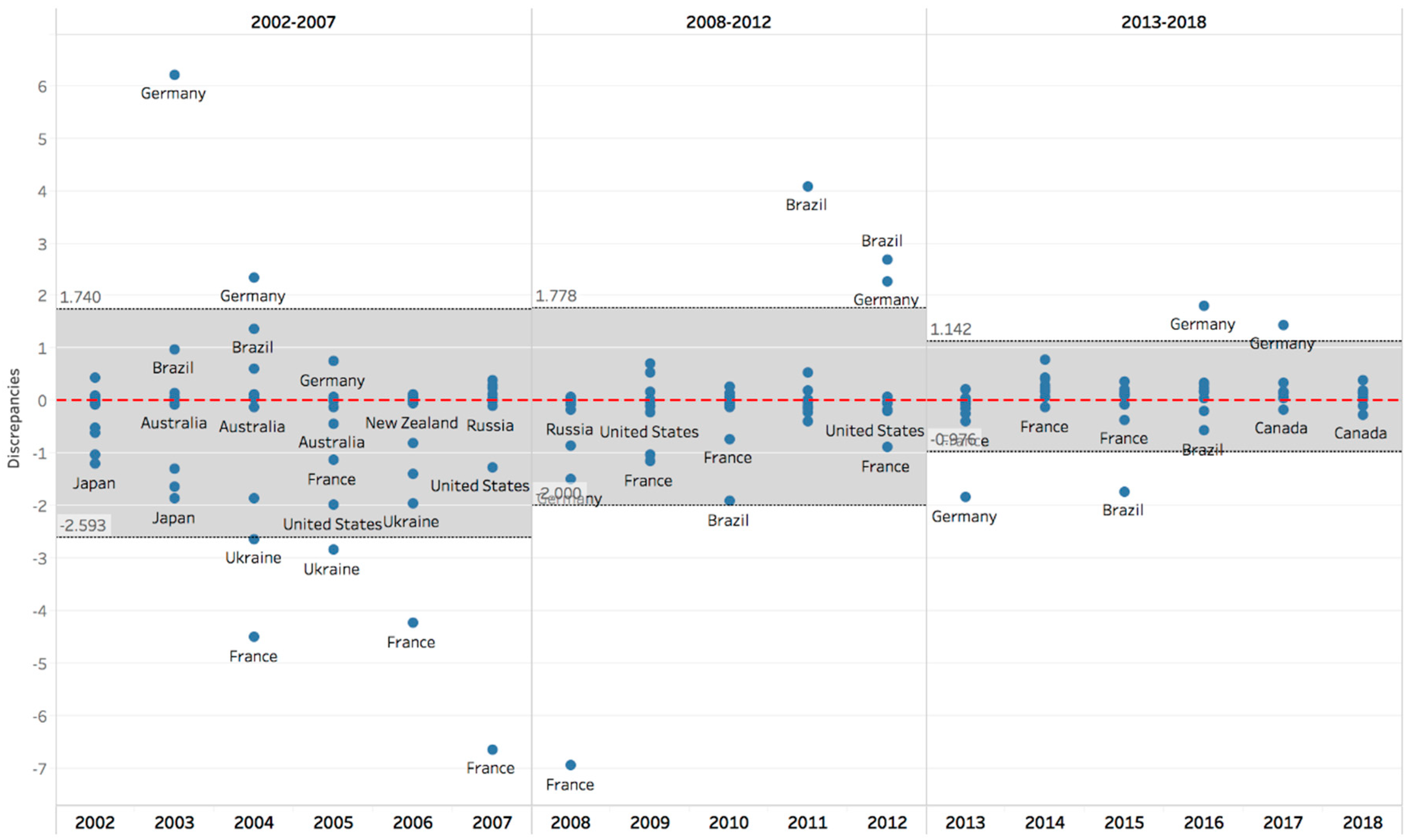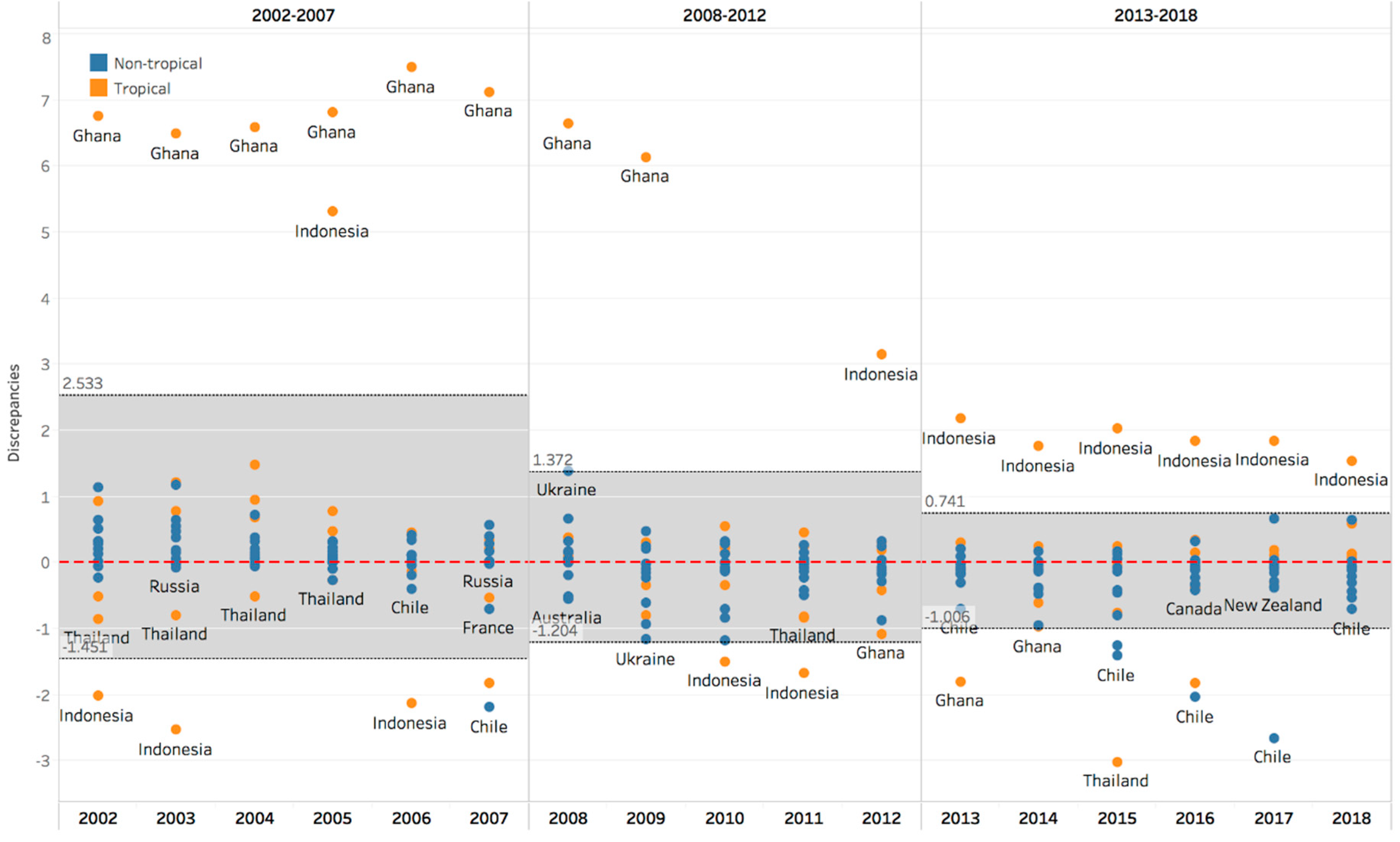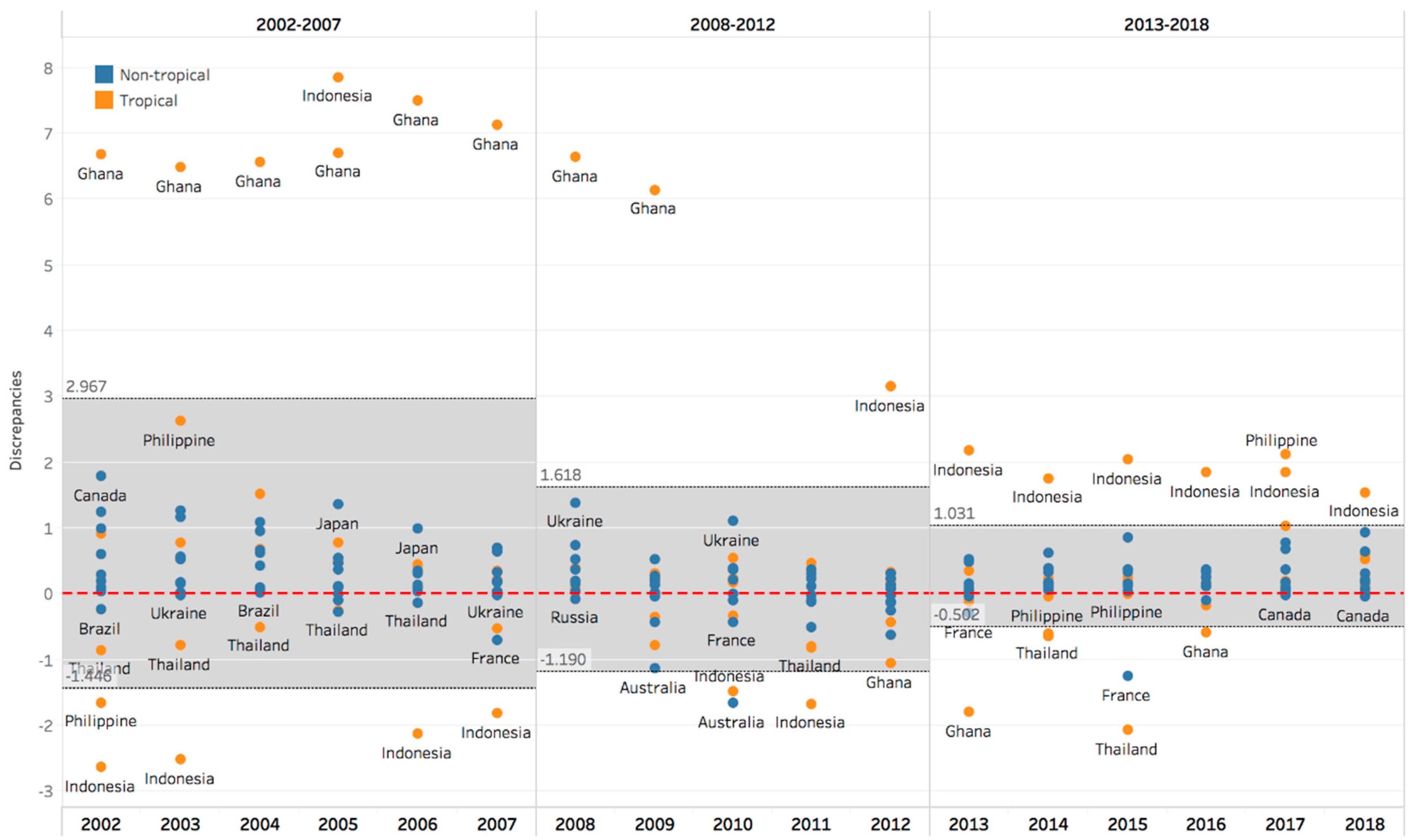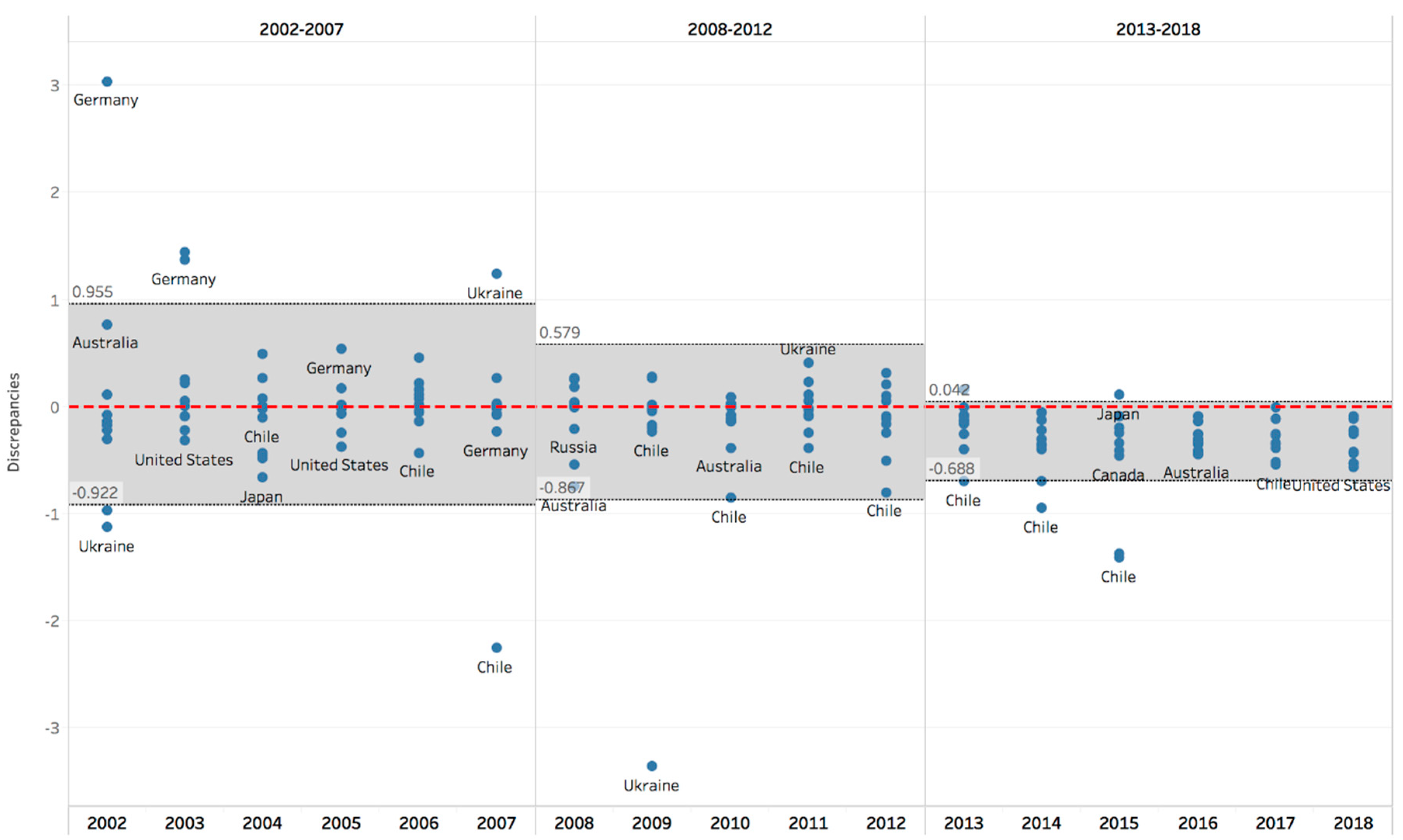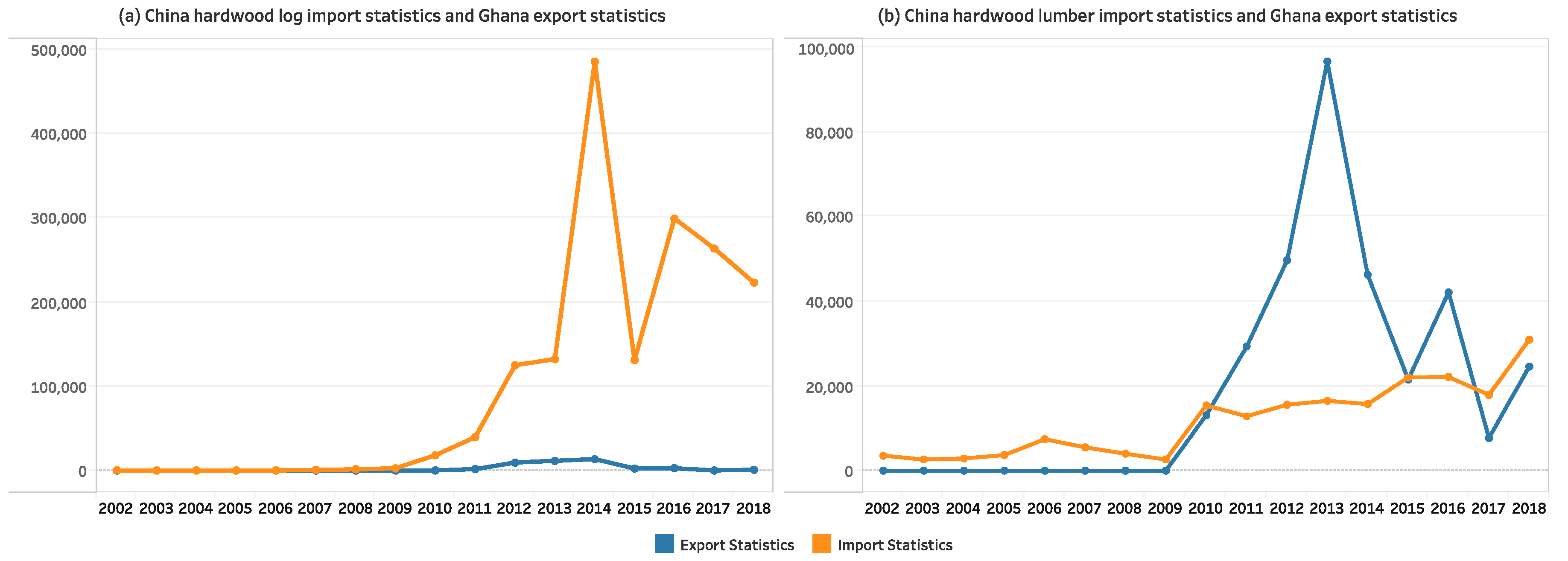1. Introduction
Trade discrepancies refer to a significant difference between the recorded data of the importing country compared with the data reported by the exporting country for a specific product within a defined time frame. According to data from the Global Trade Information Services (GTIS), the total global trade volume of logs and lumber hit an all-time high in 2018 of 992.92 million m
3, a growth of 13.69% since 2017 [
1]. In terms of imports, logs and lumber amounted to 476.34 million m
3 by volume in 2018, but exports amounted to 516.58 million m
3, with a gap of 40.24 million m
3. The data indicate a large trade-discrepancy remains, and this is not unique to 2018. Every year there are large discrepancies in timber trade statistics.
Timber products, especially logs and lumber, are basic raw materials for people’s living and livelihoods. Trade discrepancies in timber trade statistics have attracted special attention as they have the potential to lead to poor policy decisions relating to forestry management and forest products manufacture and trade, a misunderstanding of what is happening in a country’s forestry sector, a loss of income for the forestry industry, and even a degradation of forest resources [
2]. Some factors associated with trade discrepancies, like shipment time-lag, scaling methods, scaling units, unit conversion, etc., are discoverable and fairly consistent (see
Table 1).
Likewise, national data collection and classification systems reflect trade discrepancies but can be adjusted. In general, trade statistics and information are sourced directly from domestic agencies, or they can be obtained from organizations that compile and disseminate global trade data. The Food and Agriculture Organization of the United Nations (FAO) employs the Standard International Trade Classification (STIC) system as their statistical classification criteria for timber, which reclassifies products after collecting data from national governments, customs, and other organizations [
3]. Large trade discrepancies can appear when comparing data from FAO and others using STIC with sources that use the Harmonization System Code (HS code). These are recognizable causes of trade discrepancies that, along with shipment timing issues, statistical errors, and compliance issues related to various government regulations, are considered unintentional causes of discrepancies that can be understood and mitigated but are difficult to be avoided.
On the other hand, misreporting, misclassification and smuggling have become significant concerns relating to timber products [
4,
5]. Laws and regulations regarding the legality of timber, export taxes, and export bans have been implemented in many countries. Protected timber species are listed by CITES to combat harvesting and trade associated with illegal timber, protect forest resources and preserve ecological environments [
6,
7]. These rules and protections lead some exporters to deliberately under-reported or not report their export quantities of timber, sometimes reporting timber products that have a high value or high tariff as timber with a low value or low tariff or common products to evade high export/import duties or to avoid restrictive export policies. Illegal smuggling may be one explanation for misreporting and misclassification to obtain greater economic benefits and avoid restrictions [
8]. However, when goods are truly smuggled, bypassing legal checkpoints, there is seldom documentation and statistics. Vincent [
9] tried to use econometric methods to reveal illegal trade activities in the Romanian forest sector by a potential indicator of trade discrepancies, but the results appeared impractical. Illegal smuggling is difficult to detect in official statistics [
10], and will not be considered as a factor nor discussed in this paper. These factors may be considered when significant trade discrepancies and trade flow cannot be explained by the factors identified previously.
The varying degrees of trade discrepancies and their factors which might be attributed to the benign cause have attracted considerable attention in recent years. Particularly, in 2009 and 2012, reports published by Chinese and American commercial departments indicated that trade discrepancies have existed in China and U.S. trade statistics that were largely affected by factors associated with shipment issues (e.g., transshipment through Hong Kong) [
22,
23]. Supplying countries might ship via Hong Kong but record exports that are ultimately destined for the mainland as exports to Hong Kong, according to the principle of destination and origin recording rules [
21,
24,
25]. By adjusting the factors of re-exports and their price, adjusting free alongside ship (FAS) or cost, insurance, and freight (CIF) basis to free on board (FOB) basis, trade discrepancies in goods (and services) trade statistics in China and European countries have shrunk by 80% of the total but still remain, accounting for
$20.6 billion in gross terms [
26]. Trade discrepancies have also been examined by “mirror data” on China and its major partners from 2003 to 2014. There was evidence that the misreporting of exports to Hong Kong had caused increased volatility in Chinese export data since 2012 [
27]. Benita et al. found that trade discrepancies were large in China–Latin American countries during 2009–2014, which might be due to poor statistical systems in Latin America, as well as to capital flight [
28]. The case of Vietnam also applied a variety of mirror statistics in 2010–2016 and indicated that the quantities of timber imports recorded by China were often higher than the reported quantities Vietnam exports, except for lumber [
29]. International trade of hardwood products in the 1980s has been examined to determine whether discrepancies exist [
14]. The results highlighted that problems associated with the collection and processing of individual export transaction records had a significant impact on trade discrepancies.
In another China case, trade-discrepancy estimation was conducted using an asymmetric measurement [
30]. With the adjustment of Hong Kong transshipment and re-export, a new and growing discrepancy emerged which amounted to
$46 billion in 2005. The author then used asymmetric ratios of import data and corresponding export data to identify trade discrepancies and the results showed strong statistical evidence of under-reporting exports at the Chinese border to avoid paying value-added tax (estimated at
$6.5 billion) during 2002–2008 [
31]. Eastin et al. measured discrepancies within the forest products sector in the data on the U.S. and its partners in 2001 using an asymmetric equation [
13]. The results were calculated based on the import values and showed that the discrepancy ratio became smaller as the degree of processing increased. Another study particularly focused on the input-output model to discuss trade discrepancies [
17]. However, the input-output tables (I-O tables) have several assumptions in the preparation process, for example, assuming that an exporting individual and a non-exporting individual behave similarly in the industrial sector and a fixed industry structure is applied, which is inconsistent with the data of various countries. These studies did not consider the discrepancies that may result from transportation and the resulting lag between report of the export and recording of the import. The study used import and export recording dates from the U.S.. and China to calculate the time lag, which indicated that the U.S. (eastbound) imports were reduced by
$3.05 billion in 2010 [
23]. Substantial and detailed custom documents were difficult to investigate and access. Therefore, this study will develop a formula to calculate trade discrepancies considering the shipment time-lag and explore the influencing factors associated with trade discrepancies.
The effectiveness of any analysis and the resulting conclusions depends, of course, on the accuracy of the data utilized. Trade discrepancies can lead to policy errors, misdirection in the industry, a misunderstanding of trade imbalances, and even potentially a trade war [
16,
32,
33]. Within the global timber supply chain, China is a key supply chain node within the remanufacturing and redistribution hub and is ranked as the top destination for logs and lumber imports [
1]. Therefore, this study will take China logs and lumber as a case study to explore a more nuanced understanding of the discrepancies in timber trade statistics and the factors contributing to these trade discrepancies in order to establish policies or reforms that help reduce trade discrepancies and allow timber trade to remain sustainable.
1.1. Background
1.1.1. Trade Flow
China is the largest importer of logs and lumber in the world, which accounted for
$20 billion (34.9% of total global imports) by value and 109 million m
3 (22.9%) by volume in 2018 [
1]. China has become a wood product remanufacturing and redistribution center due to the combination of scarce domestic forest resources, low-cost manufacturing, and surging foreign demand [
34]. China then consumes much of this wood domestically but also exports a large amount of wood furniture and plywood throughout the world, particularly to the European Union countries and the United States [
1]. China now is playing a leadership role in the export of wood furniture and wooden panels in the world, amounting to
$ 35 billion in 2018 (see
Figure 1).
More than 150 countries export logs and lumber to China. New Zealand (39.6% of total imports), Russia (19.6%), and the United States (12.5%) are the three largest softwood log suppliers in 2018, and Russia (48.3% of total imports), Thailand(13.5%), Canada (9.6%) and the United States (7.8%) are largest lumber suppliers in 2018 (see
Figure 2). Other countries, such as France, Germany, Brazil, Indonesia, Malaysia, Philippines, Chile, Finland, Sweden, Ukraine, Ghana, and Japan, are also major exporters to China, but with a smaller proportion. China also imports logs from some developing and tropical countries that have led to China being considered as a key consumer of illegally-sourced timber [
35]. Some log exporters in these countries do not pay required royalties to the exporting nations nor do they exercise proper environmental control over harvest operations [
36]. Looking specifically at China’s supply of tropical hardwood logs, African countries, the Solomon Islands and Papua New Guinea account for around 30% of China’s imports. While we would like to include these countries in this study, they do not report their exports to GTIS and we, therefore, cannot calculate a trade discrepancy within the data we have available.
1.1.2. Government Policies for Forest Harvesting and Timber Trade
Figure 3 shows a timeline of the major government policies for forest harvesting and timber trade in China and its partner countries. Regarding trade policies for timber products, China has maintained an open market and low tariffs in bilateral trade since joining the WTO in 2001, which has provided more benefits and opportunities for countries to export to China. Zero import tariffs on logs and lower value-added tax and customs duty on logs and lumber (7% on logs and 13% on lumber), combined with relatively low wages and high productivity, have created a competitive advantage for China in world forest products markets and trade [
34,
37]. Concurrently, China has signed bilateral free trade agreements with many forest products partner countries, which has led to the growth and expansion of China’s import and export trade and has developed mutually beneficial markets with these countries (see
Figure 3). Recently, a ban on the commercial harvesting of natural forests was enacted in 2017, which has limited China’s domestic timber supply [
38]. Importing more logs and lumber has enabled China to meet a rapidly growing international and domestic manufacturing and construction demand.
Many supplying countries have enacted protective trade policies and are advocates of combating illegal timber harvesting and trade. Since the G8 organization proposed the Forest Action Project in 1998, the United States, EU, and several other countries have introduced rules, laws, and regulations to combat illegal logging and timber trade. In 2008, the United States introduced an amendment to the Lacey Act, requiring that forest products, such as wood and furniture imported into the United States have proof of legal sourcing [
39]. In the same year, Russia added quotas and an export tax to restrict log exports, reduce the loss of forest resources, and increase domestic processing, job creation, and revenue for the domestic forestry industry [
40]. Since that time, there has been a dramatic change in Russia’s wood exports to China, with log exports declining substantially and lumber exports increasing rapidly (see
Figure 2).
In 2009, the European Union adopted the Forest Law Enforcement, Governance and Trade (FLEGT) plan to reduce illegal and unsustainable logging in supplying countries [
41]. Subsequently, they enacted the EU Timber Regulation and implemented Voluntary Partnership Agreements (VPAs) to achieve the goals of FLEGT. About 90% of the imported timber products in the EU market were covered by the EUTR in 2013 [
42]. Supplier countries with abundant forest resources, such as Indonesia, Malaysia, Philippines, Ghana, Thailand, and Ukraine, have successively proposed bans on log exports, limiting the loss and harvesting of precious species of wood and protecting the ecological environment [
43]. In addition, these countries implemented export or logging bans to create job opportunities and improve their forestry industry [
41].
The Chinese government has been taking actions to combat illegal timber trade, including the promulgation of the 2010 Public Timber Harvesting and Purchase policy and the promotion of forest certification [
34]. Many NGO organizations have taken steps to encourage companies to remove illegal or unsustainable timber from their supply chains. Supplying and trading corporations, both public and private, now use voluntary certification systems, such as FSC and PEFC, to identify their sustainable and legal products [
36]. All the work has had a positive effect on the sustainable trade of wood products [
44]. The proportion of illegally sourced timber has decreased and the proportion of certified wood products is increasing [
34].
1.2. Objectives
The results of existing studies may be less applicable in the recent timber markets considering the substantial changes in trade flow and trade policies, particularly after China joined in WTO in 2001. For example, as Russia raised log export tariffs in 2008, the import volume of softwood logs from Russia to China declined from 21.1 million m
3 in 2007 to 9.5 million m
3 in 2018 [
1]. China also switched to importing softwood logs from sustainably managed plantations in New Zealand, reaching 19.2 million m
3 and 39.2% of the total imports in 2018. Factors relating to trade discrepancies need to be further explored and updated. This study seeks to measure the discrepancies in timber trade statistics using a time-lagged function, and specifically considers China and its partners’ logs and lumber trade data from 2002 to 2018 as a case study based on customs data available in GTIS. The study hopes to fill a gap in the literature by attempting to isolate both the unintentional and intentional factors behind identified discrepancies and provide an account of the reasonable explanations and incentives for trade discrepancies. By doing so, this study hopes to add to our collective ability to effectively interpret, control and reduce discrepancies in the timber trade, and improve the accuracy and reliability of trade data. Accordingly, the three objectives of this study are:
To develop the time-lagged function in order to estimate timber trade discrepancies, after adjusting the measurement and transshipment factors;
to summarize the characteristics and trends of discrepancies in log and lumber trade statistics and analyze the possible factors contributing to large discrepancies;
- (a)
to describe the historical variation of trade discrepancies;
- (b)
to summarize and analyze the characteristics and changes of trade discrepancies by country;
- (c)
to compare trade discrepancies of different classifications and regions using statistical tests; and
to discuss the possible factors that may impact the occurrence and scale of trade discrepancies, like international trade policies and regulations.
2. Materials and Methods
The data in this study were sourced from the Global Trade Atlas, a trade database developed and maintained by Global Trade Information Services, Inc. (GTIS). GTIS purchases, collects and publishes trade data from over 80 countries and regions, going as far back as 1990. GTIS data were gathered from the official customs or national statistics agency of each reporting country responsible for tracking and managing trade. The system provides information on the value, quantity, and unit price and was classified using the Harmonized System. While some countries do not share trade data in the GTIS, such as Papua New Guinea, Solomon Islands, Vietnam, and much of Africa, in terms of volume and value, GTIS captures most of the world’s trade flows across all industries and products, compared to other data sources.
China was one of the reporting countries that provided both volume and value data to GTIS by the China Custom. However, some of China’s partner countries were not GTIS reporting countries. Given the data availability and quality, 14 hardwood log trade partners, 10 softwood log trade partners, 13 hardwood lumber partners, and 10 softwood lumber partners were considered in this study, as shown in
Table A1. These representative partner countries accounted for more than 80% of China’s log and lumber imports on average. Such data processing focused on the largest trade flows helped to avoid time-consuming analyses of discrepancies that may appear large as a percentage but were insignificant in terms of actual volume. It also improved the interpretability of the results. The countries’ reporting data, including Australia, Brazil, Canada, France, Ghana, Indonesia, Malaysia, New Zealand, Philippines, were sourced from their national statistics agencies. Some of the supplying countries’ trade data (Chile, Russia, Thailand, and Ukraine) were sourced from their official customs. Some of the supplying countries’ trade data were sourced from Eurostat (Germany), Ministry of Finance (Japan), and Department of Commerce (U.S.).
Moreover, this study used a consistent unit of cubic meters for logs and lumber, for which GTIS applied a conversion factor of one metric ton is equivalent to 1.4268 cubic meters [
1] to minimize the errors caused by the scaling measurement and the different units.
Classification System: Goods are most commonly classified using the Harmonized Commodity Description and Coding System (HS), which uses a nomenclature of ‘HS Codes’, developed by the World Customs Organization to classify commodity groups [
45]. This system is used by more than 200 countries and economies as a basis for customs tariffs and the collection of international trade statistics. The HS Code allows for the subdivision of wood products both by product type as well as by species.
Many prior studies of trade discrepancies used four-digit or two-digit level HS codes [
46]. This study applied six-digit level HS codes for logs and lumber products. Hardwood logs (HS code 440312, 440331–440335, 440341, 440349, 440391–440399, 440341, and 440349), softwood logs (HS code 440320–440326, and 440311), hardwood lumber (HS code 440721–440729, and 440790–440799) and softwood lumber (HS code 440710–440712 and 440719) were employed in this study. The changes in the classification system were considered and checked in our analysis, such as the code changes for softwood logs and softwood lumber in 2017.
Hong Kong Transit Factor: While Hong Kong’s role as a major cause of trade discrepancies has diminished since 2005 [
31], Hong Kong remains one of the mainland’s main ports. There were few records indicating that mainland China imports logs and lumber from Hong Kong, but the Hong Kong records still listed unreciprocated volumes of logs and lumber exported to mainland China. The volume of logs and lumber from Hong Kong accounted for about 15% of China’s imports in GTIS. Therefore, this study combined the import trade data on Hong Kong and China to remove re-export and transit through the Hong Kong port to reduce this source of unintentional discrepancies.
Shipment Time-Lag Factor: Importing countries reporting shipments in a different time period is normal due to long distances and the period for transit, especially when there is a number of timber products exported at the end of the quarter/year that may not arrive at the importing country until the following quarter/year. This study assumed that the change should be the same on the import side within the period [
t,
t + 1] and the export side within period [
t − 1,
t], if the transportation time was 1. This was also observed and discussed in numerous previous studies [
5,
11,
12,
26,
47], which indicated that import data in time
t should be equal to the exporters’ data in time
t − 1, if the transportation time was 1. Shen [
47] took the time-lag factor into analysis and calculated the factor based on the export data, but others didn’t consider it. Prior studies also indicated that import data were more reliable than the corresponding export data [
13,
30]. In this study, the time-lag adjusted factor formula (Equation (1)) was established with these assumptions according to Shen [
47], then modified based on the import data. In this equation, the time-lag factor
lit is modeled as a function of
T, which represents the transportation time in months and the ratio of the import volume for periods
t + 1 (
Mit+1) and
t (
Mit). This ratio represents the change ratio of the import volume in transportation time.
Generally, the actual transportation time was difficult to estimate and can vary by weather conditions, custom clearance processes, and complex transportation routes. For example, the transportation time from the east coast of China to the east coast of the U.S. would be quite different from that from the east coast of China to the west coast of the U.S. [
23].
Table 2 shows the average transportation time used in this study, according to a Ningbo transportation enterprise, which settled at the main seaports on the east coast of China (in Zhejiang province). The shipping time is the estimated time for arriving at Ningbo port, considering possible transshipment routes.
The time-lag factor lit is the “adjustment coefficient” of China’s imports after factoring in the transportation time. Quarterly data series were used in this study, which considered a reasonable shipping time between China and its partners. Accordingly, the “new” time-lagged export data were calculated using Equation (2).
where
Mit is the reported imports of China from exporter country
i in the time period
t;
Xit is the reported exports of exporter
i to China at time
t, and
T represents the transportation time period in months.
Discrepancy Measure: The discrepancies measure presented in Equation (3) is based on Ferrantino et al. [
31]. The natural logarithm of the ratio of the imports (
Mit) and the time-lagged exports, as the trade discrepancy measurement, is used in this study. Then, we use the time-lag factor and the “new” export data (time-lagged exports) to estimate the discrepancy ratios by Equation (4).
Equation (2) is a relative measure that represents the discrepancy measures as a proportion of the overall reported imports, making the score independent of the overall volume traded. However, the time-lagged factor in Equations (2) and (4) depends on changes of the imports, and the new export data are thus estimated based on the time-lagged factor, then the trend of the new export data and import data is performed similarly according to the aforementioned assumption. Through this process it is not unusual for trade discrepancies to change between negative and positive after adjustment.
Table 3 shows an example of lumber trade discrepancies between China and the U.S. in 2015. The gap between the trade discrepancies with the time-lag factor, compared to without the time-lag factor, has narrowed and is much closer to zero. Therefore, these adjustable factors—the classification system, the Hong Kong transit factor and the shipment time-lag factor have helped reduce discrepancies. Trade discrepancies of lumber in China-U.S. show the smallest discrepancies in the first quarter of 2015 with the value of −0.012, which indicates that China reports 0.988 (equals to e
−0.012) times lower import volume than the U.S. reports as the export volume. A deeper understanding of trade discrepancies and their variation will be obtained by using the discrepancy measurement formula above as developed in this study.
4. Discussion
The results of this study demonstrate that there remain large trade discrepancies in logs and lumber data that fall outside of the “normal” range in some cases. Given that factors associated with the time-lag shipment and statistical errors have been adjusted and explained, there remain factors that affected the size, distribution, and variation of the trade discrepancies.
One of these factors is re-export. It still exists in China-Chile due to the characteristics of their geographical locations. Chile reported higher exports than China imports in softwood logs and lumber in 2015–2017 (see
Figure 9 and
Figure 11). Bolivia, which is rich in forest resources, has historically always imported and exported through Chilean ports [
48].The Chilean export records consequently include domestic exports and volumes re-exported through Chilean ports, but when goods were delivered to China, customs recorded these re-exports or transshipped goods as sourced from their original export territory and only the Chilean domestic goods as sourced from Chile. Hence, re-exports created a discrepancy in the international account. Similarly, goods from European countries such as France and Germany are exported to another destination, creating substantial re-export/transshipments in the process. While transshipments are not included in re-export data, discrepancies may remain because goods are shipped via a third country but without clearing customs.
There are still many unexplained large discrepancies in the trade statistics for hardwood logs and lumber imported by China from Southeast Asian countries and Ghana (see
Figure 7 and
Figure 10). As discussed in previous studies, under-reporting or non-reporting appears to have existed widely in the hardwood logs and lumber trade in these countries [
49,
50,
51]. As such, Ghana’s hardwood log export volumes were quite low, compared with China’s recorded imports, while the recorded hardwood lumber exports from Ghana to China were much higher than the imports recorded by China in 2011–2016 (see
Figure 7 and
Figure 10). In addition, the trends in China’s log import statistics line up fairly well with the trends in the lumber exports reported by Ghana (see
Figure 12). The gap in the trade statistics in China–Ghana has shrunk by about 10% when aggregating products, indicating that misclassification of lumber and logs may occur in Ghana–China trade. It should be noted that Ghana implemented a Rosewood harvesting and exporting ban in 2014 (see
Figure 3). Exporters may misclassify or misreport the products to avoid export bans, quotas or taxes, taking advantage of possible weaknesses in the government’s management system [
52,
53,
54]. Misclassification may not be a result of smuggling or tax avoidance, but rather may be due to inconsistencies in classification practices, it can account for as much as 3%–5% of discrepancies [
55].
Likewise, the reported exports of hardwood logs from Indonesia are only 35.9% of total China’s reported import data during 2002–2018 [
1], which are showing large positive discrepancies in
Figure 7. Raw log export restrictions and logging bans were announced in Indonesia in 2002, which could be considered as incentives to under-report or non-report [
8]. Exporters may forge transport documents for domestic forest over-harvesting and ignore the legal restrictions and regulations of the government. Indonesia’s forest management system and institutions are often said to be manipulated and corrupt [
56], and policies are inefficient instruments for correcting their domestic distortions [
57]. While large discrepancies may be unintentionally recorded errors, a continuous under-reporting of exports seems evident and not an accident. Misreporting or misclassification is largely contributed to the unexplained discrepancies. The same considerations are valid for the large positive trade discrepancies between China and the Philippines, China and Thailand. Another possibility is that China deliberately reported high imports, but there is no supportive and strong evidences to explain such behavior. There may be incentives for a Chinese importer to under-report, but intentionally over-reporting is difficult to explain. More in-depth explanations and surveys are required, which may be sought through the use of tracking systems.
Tropical countries, including Malaysia, Indonesia, the Philippines, Thailand and Ghana, played an important role in China’s hardwood log imports in the past but have contributed less in recent years, accounting for 57.8% and 1.3% of China’s total hardwood logs imports in 2002 and 2018, respectively, as show in
Figure 2. Trade flows of Chile, France and Germany accounted for 0.7%, 0.8%, and 1.2% of total China’s import data, while they have large trade discrepancies (see
Figure 2). These countries’ trade flows are relatively minor within the overall context of logs and lumber trade with China. In contrast, the larger trade flows of logs and lumber between Russia, New Zealand, and the U.S. (above 10% of total China’s import) showed small trade statistics discrepancy ratios, which were less than ± 0.06.
In addition, overall trade discrepancies in logs and lumber have been reduced significantly since 2008 (see
Figure 5). This may due to the implementation of the U.S. Lacey Act 2008, which impacted the Chinese timber trade [
39,
42]. Imported logs and lumber in China are heavily used for manufacturing furniture and wooden flooring and are mainly exported to the U.S. and Europe. With the growing recognition of legality sourcing and the certification of forest products, Chinese exporters have begun to prefer the importation of legally sourced logs and lumber from the U.S. [
58,
59]. The trade statistics also showed that China has concentrated on importing logs and lumber from the U.S., Canada, New Zealand, and Russia, which are not suspected as countries that employ illegal sourcing (there is some suspicion regarding hardwood log exports from Russia, but this has been diminished significantly). Thus, fewer trade discrepancies are expected as a result of this timber legality legislation, and this may be the reason for why overall trade discrepancies are decreasing with time. In summary, government policies, both legality policies and export bans play an important role in influencing the trade discrepancies.
It should be noted that there are still some discrepancies in logs and lumber trade with China. As discussed above, these trade discrepancies are possibly due to re-exports and transshipment, misreporting or misclassification. This research has helped identify areas in need of further examination. Though the time-lagged function reduced part of the trade discrepancies in this study, the adjusted transport time did not fully explain the trade discrepancies. To determine an exact shipping time, further information and documents are needed. Further adjustments through considerable investigations and statistical methods are also worth considering.
Minimizing trade discrepancies can not only reduce the loss of trade revenue and avoid conflicts caused by trade imbalances but also provide policymakers with a reliable reference basis. Legislators, government bureaucrats, business leaders and academic researchers who rely on international trade data, therefore, expect and support efforts to improve trade statistics. Exploring the influencing factors in various countries associated with trade discrepancies at the disaggregated product level helps us to propose management and supervision suggestions and insights regarding irregular behaviors and activities to ensure the sustainability of the timber trade.
Recommendations for further reducing and eliminating trade discrepancies include the following. Strict timber harvesting and the trading system should continue to be improved and established to help local governments eliminate corruption, misreporting, and smuggling. Fair competition for sustainably produced timber products and the legal supply chain of raw materials from the forest sector must be encouraged and enabled within timber markets. It is also necessary to strengthen international cooperation in trade statistics. The trade statistics system requires data from all participating countries involved in trade and investment between countries and even subdivides into international import and export enterprises. The great amount of data needed are difficult to obtain by one country alone. International cooperation to improve the accuracy of trade statistics should be pursued.
5. Conclusions
This study developed a time-lagged function to calculate the timber trade discrepancies between China and its partner countries, with some adjustments associated with shipment issues and statistical errors, then discussed possible factors and incentives for specific trade discrepancies. The range of overall discrepancies in the logs and lumber trade statistics have been significantly reduced over time. However, both trend analyses and statistical tests indicated that there are still large discrepancies at a disaggregated level, especially for hardwood logs and tropical countries. To provide a more specific understanding of the trade discrepancies, the trans-shipment or re-export through the European and Latin American countries may explain the large negative trade discrepancies in France and Chile, and misclassification and misreporting are considered to explain a significant proportion of the large positive trade discrepancies in Southeast Asian and African countries like Ghana, Indonesia, the Philippines, and Thailand.
Given the expansion and development of the timber trade market, government policies, especially legality regulation and export bans, may play an important role in the variation of timber trade discrepancies. More specifically, Ghana, Indonesia, Thailand, and the Philippines have reported positive trade discrepancies, which indicated that these countries reported much lower export values than China reported as imports. If exporters under-report quantities intentionally in order to evade export taxes or quotas, then one might expect the reported exports to be lower than the reported imports. It is widely recognized that under-reporting, non-reporting or misclassification may exist due to poor management systems and corruption in local governments, which lead to significant trade discrepancies. However, with smaller amounts of China’s imported logs and lumber coming from Southeast Asia countries in recent years due to the implementation of legality policies and other improvements in trade control have narrowed the range of trade discrepancies for logs and lumber on the whole.
While intentional factors associated with trade discrepancies have recently attracted attention as potential illegal practices, there is not sufficient evidence to indicate and detect these using the current official datasets. The identification of detailed behaviors associated with trade discrepancies requires further and considerable investigations or interviews. Then a more in-depth analysis and adjustment of these problematic trade discrepancies should be conducted to determine the incentives for possible factors, and recommendations and policies should be developed to reduce the discrepancies in trade statistics and facilitate sustainable timber trade in the future.


